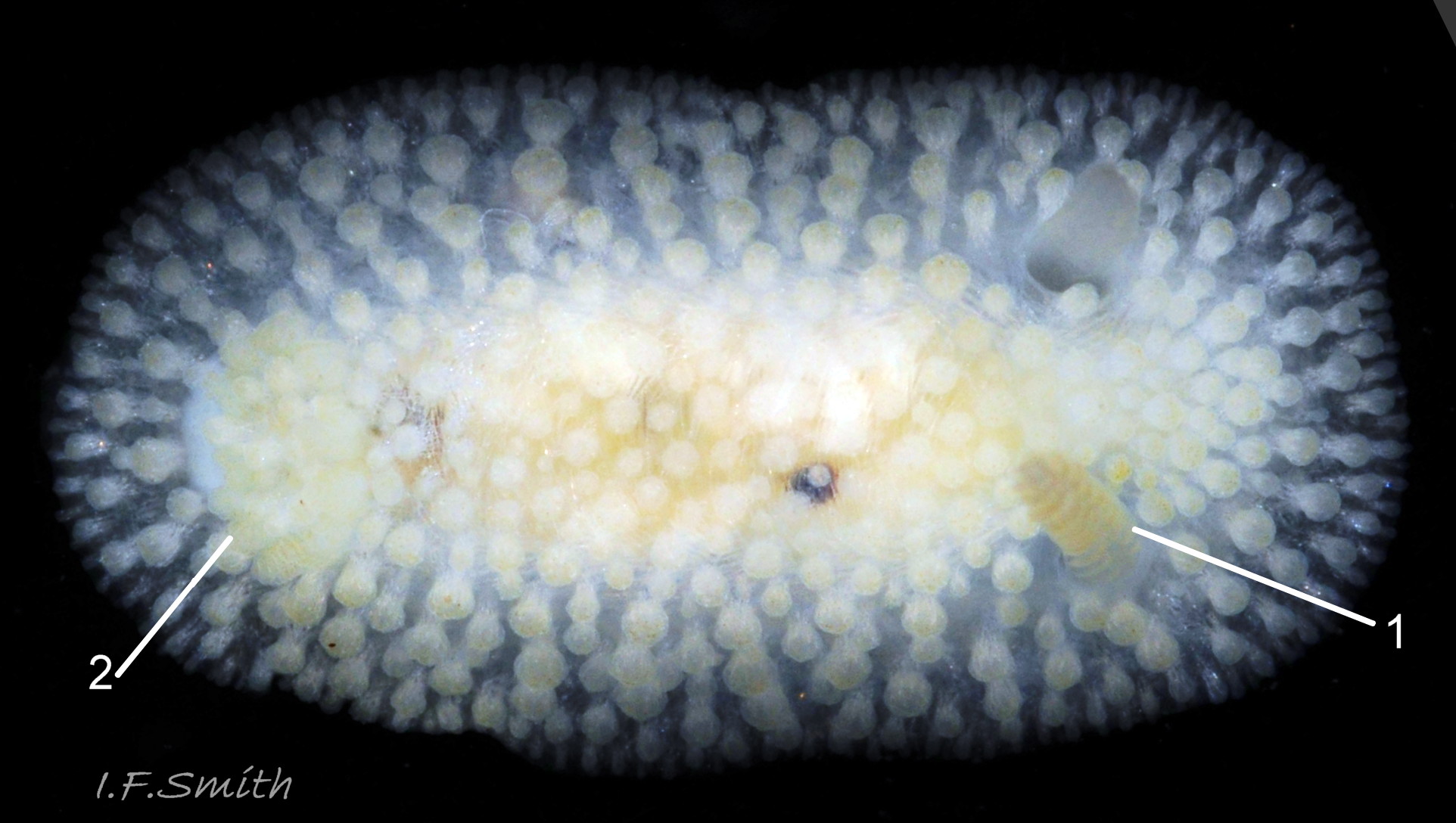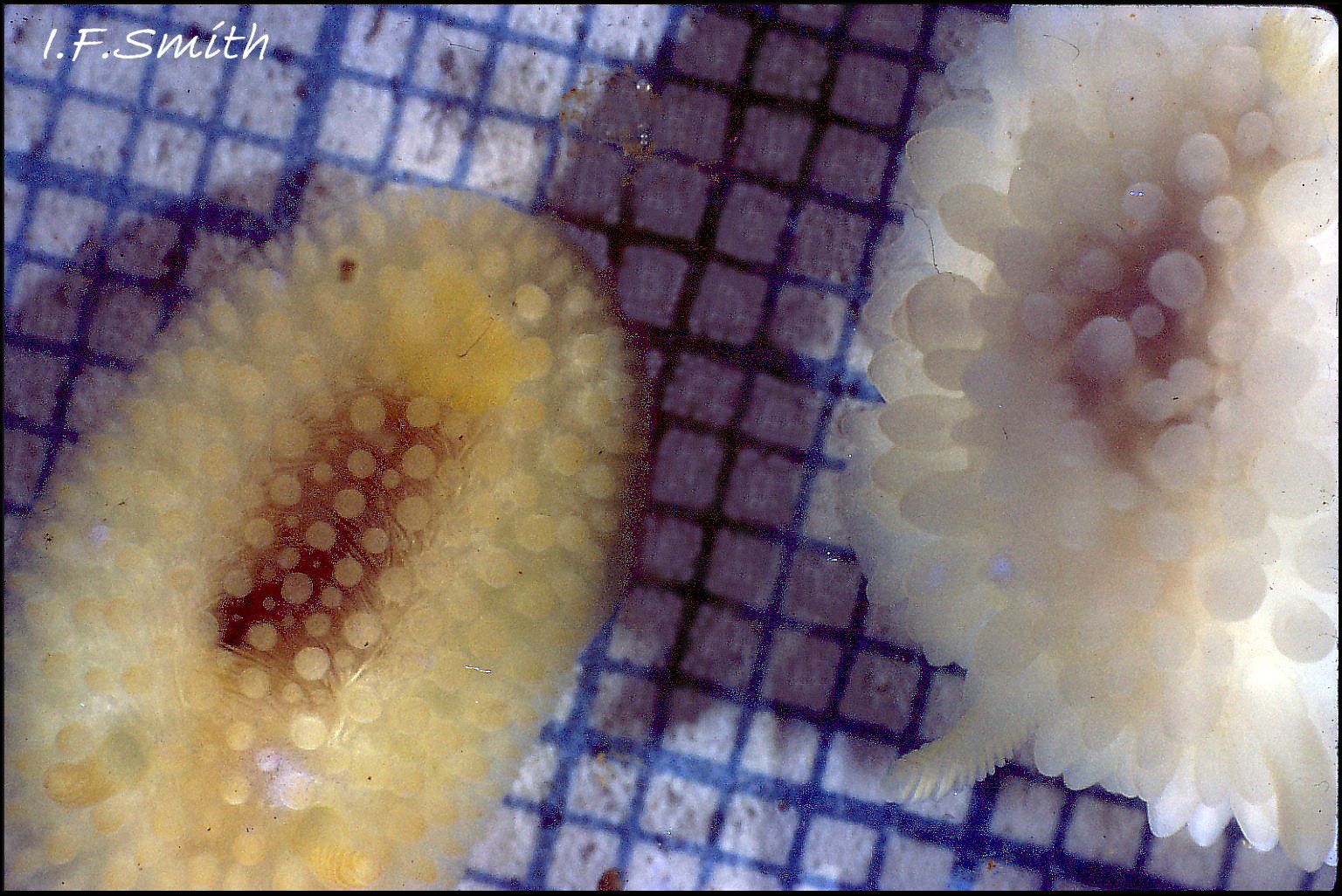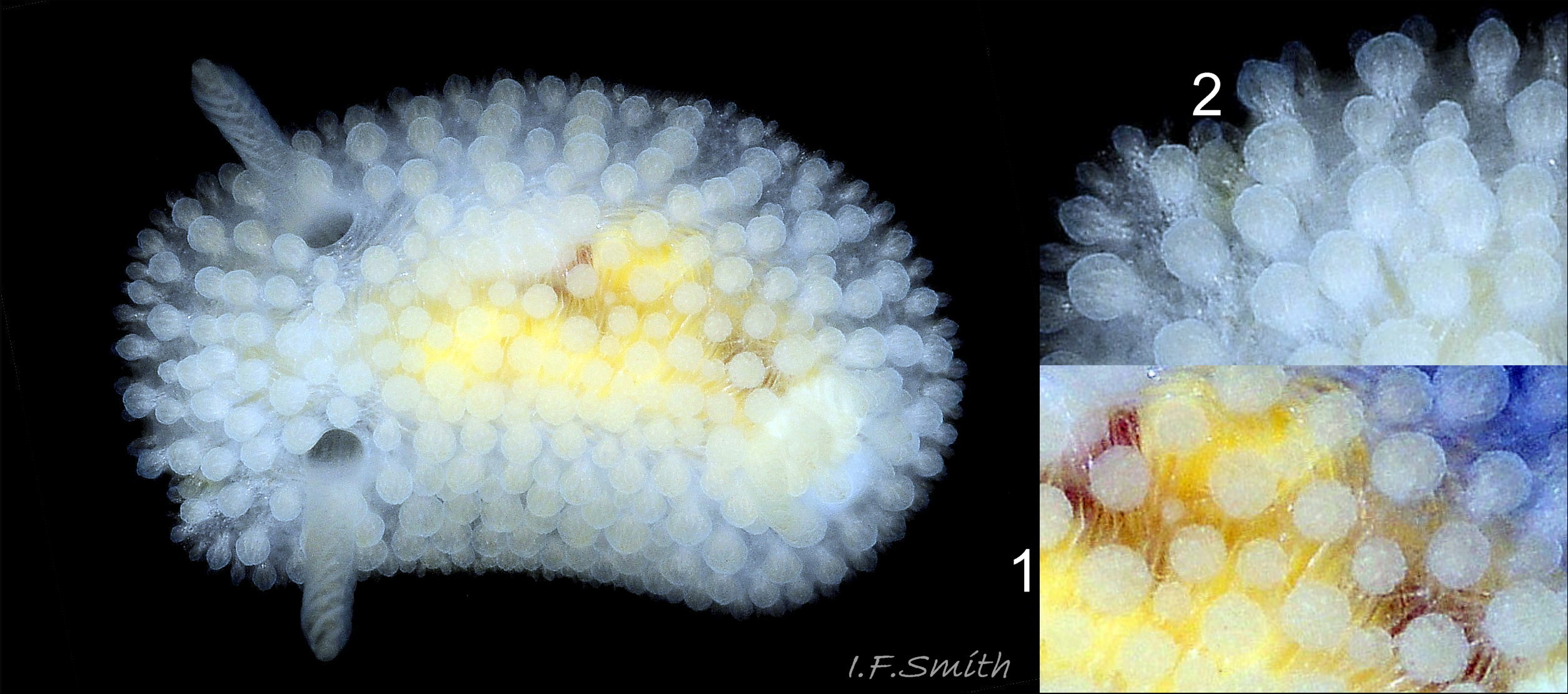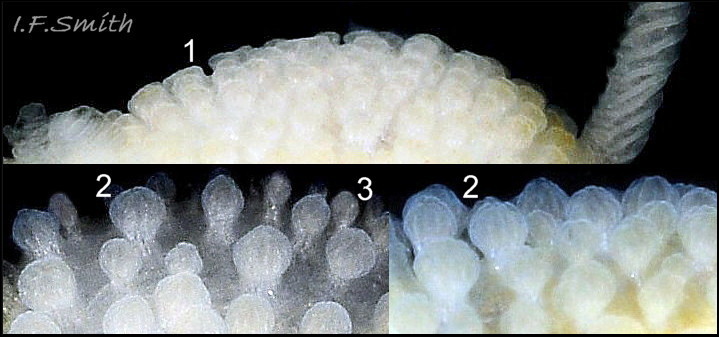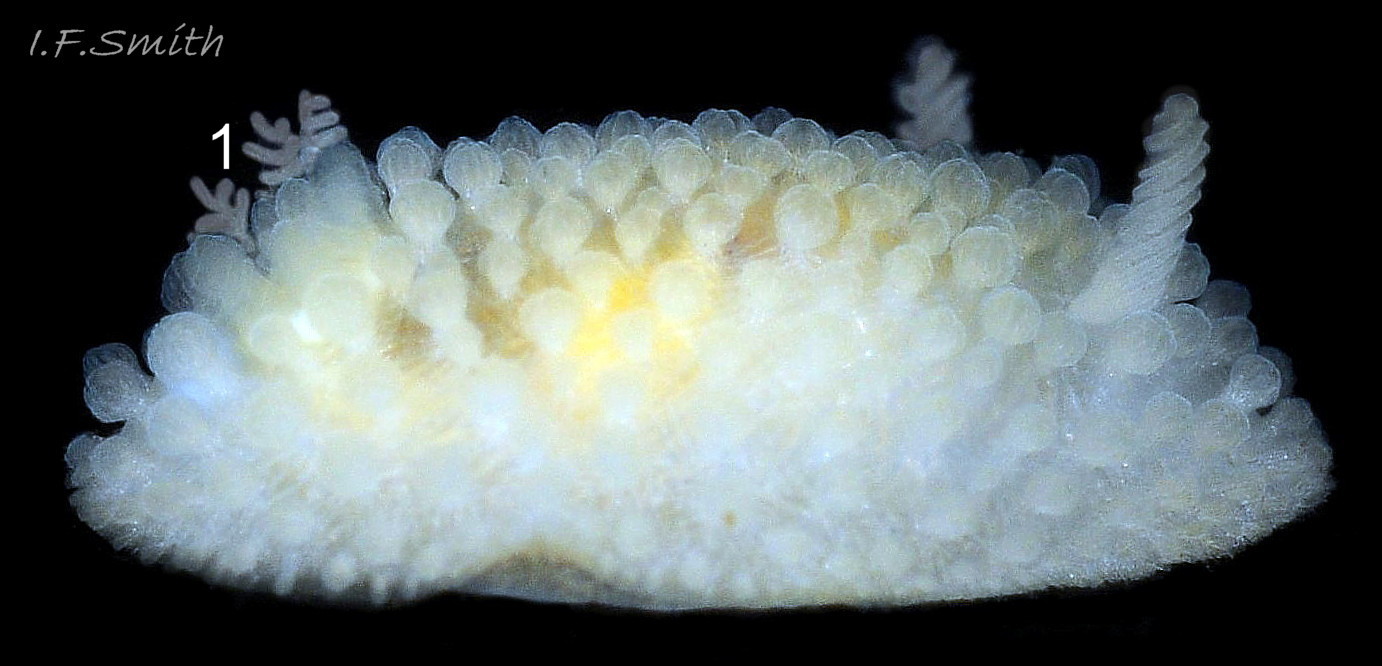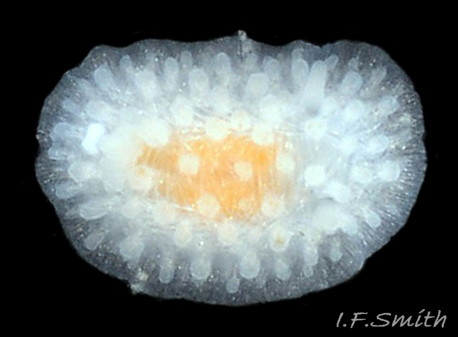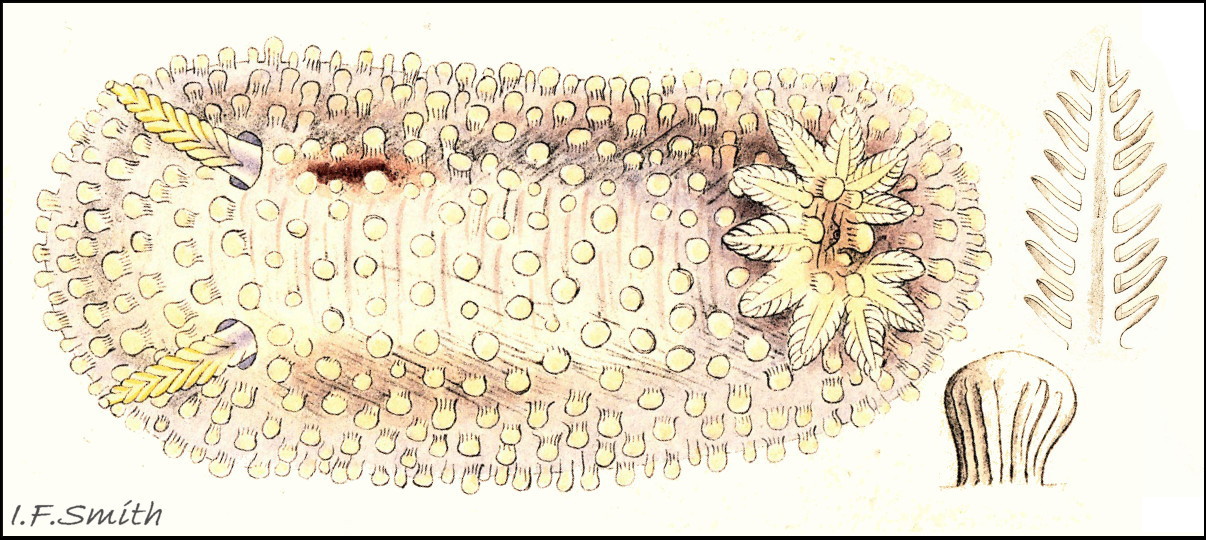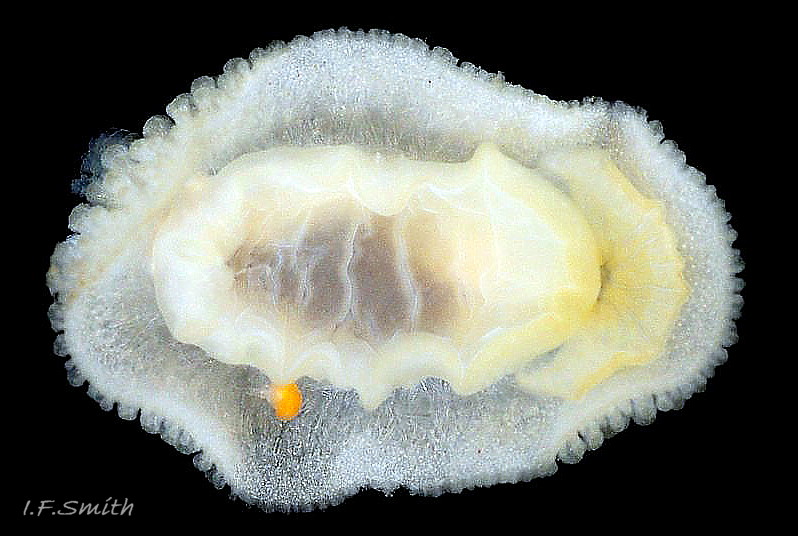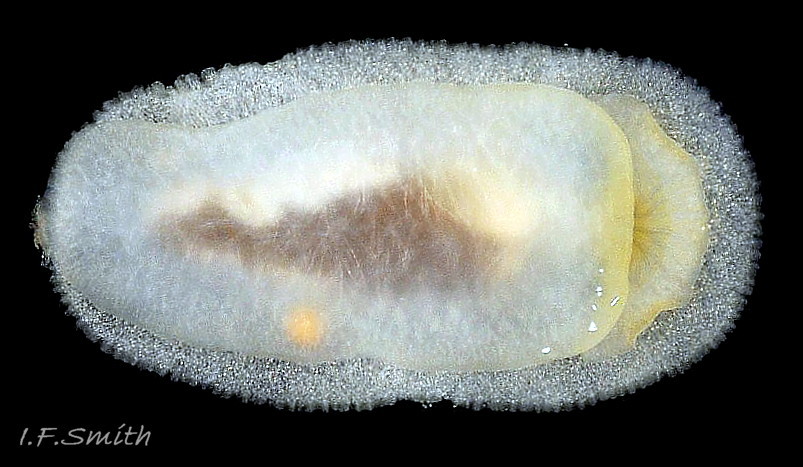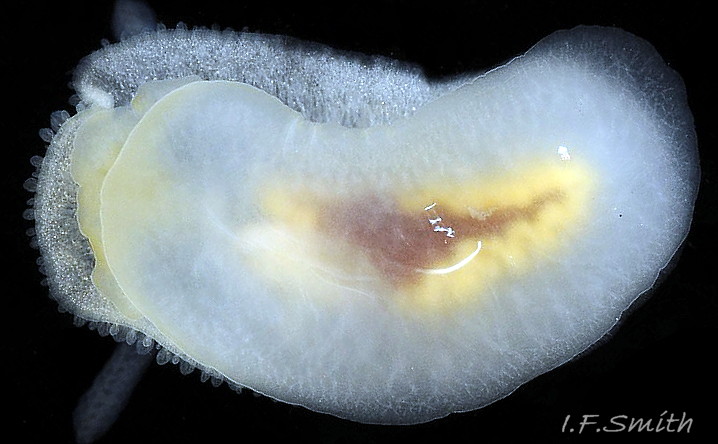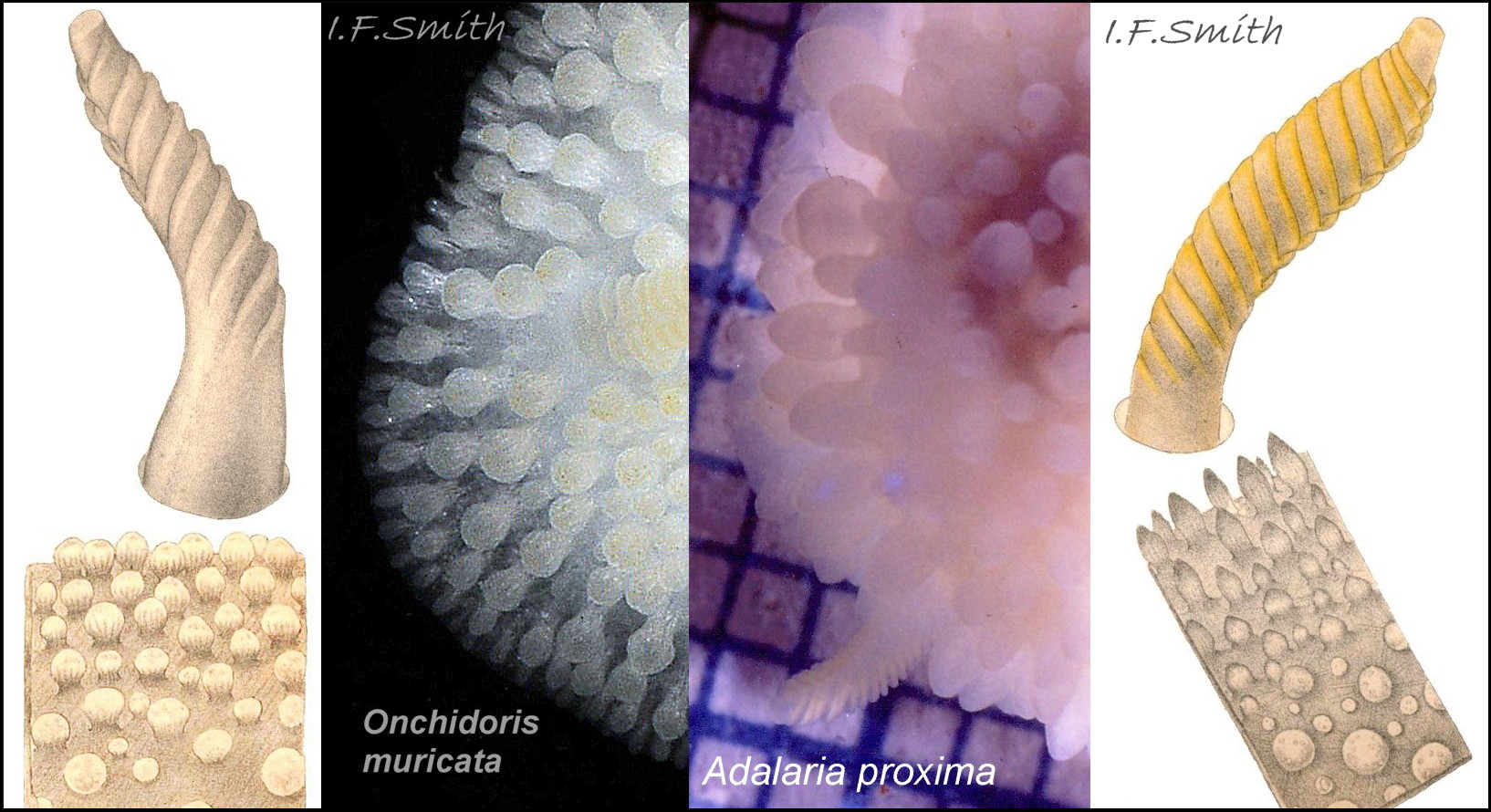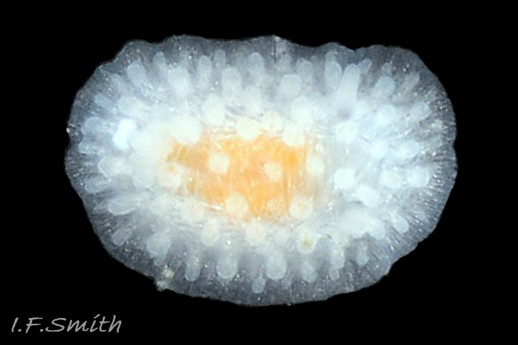Click image to enlarge with full caption. Main text below slider.
Onchidoris muricata (O. F. Müller, 1776)
Current taxonomy: World Register of Marine Species www.marinespecies.org/aphia.php?p=taxdetails&id=140640
Synonyms: Doris muricata O. F. Müller, 1776; Doris aspera Alder & Hancock, 1842; Doris diaphana Alder & Hancock, 1845; Lamellidoris muricata (O. F. Müller, 1776); Onchidoris aspera (Alder & Hancock, 1842).
Meaning of name: Onchi = tuberculate, doris = name of a sea nymph, muricata = pointed.
GLOSSARY BELOW
Description
O. muricata grows up to 14 mm long. The ample mantle covers the whole body 01 Onchidoris muricata . It is usually white or whitish in southern Britain, but can be yellow, especially in northern Scotland 02 Onchidoris muricata . Usually there is no surface pigment, only rarely it has brown freckles (Thompson & Brown, 1984). When well lit, the translucent mantle may show yellow and/or brown viscera and glass-like spicules embedded in the mantle and tubercles 03 Onchidoris muricata . The spicules in the tubercles resemble the segment divisions of a peeled orange 04 Onchidoris muricata . The tubercles are club-shaped with flat 04 Onchidoris muricata or broadly rounded 05 Onchidoris muricata tops. The spacing of the abundant tubercles varies with the extension of the mantle; when it is contracted the tubercle-heads are very close to each other. Only the smallest tubercles on the mantle edge sometimes have pointed tops 04 Onchidoris muricata . Juveniles about 2 mm long have nearly cylindrical tubercles before they develop club-heads 06 Onchidoris muricata .
The rhinophores have a truncated apex which hardly protrudes beyond the uppermost lamella 07 Onchidoris muricata . On a 14 mm long animal, there are up to twelve oblique lamellae and, on 8 mm specimens, about ten lamellae. The basal third is smooth and nearly transparent. There is no sheath or rim around the basal pit. The lamellae are translucent white, often slightly tinted yellowish 01 Onchidoris muricata or, on yellow specimens, a more saturated yellow than the mantle 02 Onchidoris muricata .
There are up to eleven short, transparent gills, coloured as the mantle or faintly tinted yellowish 01 Onchidoris muricata , in a circle around the anus, with a gap at the rear 08 Onchidoris muricata . The posterior gills barely show above the tubercles 05 Onchidoris muricata .
The visible head consists of a large, curved, yellow- stained, oral veil with a wavy edge and an opening leading to the mouth 09 Onchidoris muricata .
The foot is usually completely concealed dorsally by the mantle, but the posterior tip may sometimes protrude. The anterior of the expanded foot varies from truncated 10 Onchidoris muricata to smoothly rounded 11 Onchidoris muricata . The translucent sole contains sparse spicules 10 Onchidoris muricata . It is coloured as the mantle and may show opaque white viscera, the tapered, brown digestive gland and yellow ovotestis 11 Onchidoris muricata .
Key identification features
O. muricata
1) Club-shape tubercles on the mantle have flat or broadly rounded tops 04 Onchidoris muricata , only a few small ones at the mantle edge have a narrow apex.
2) Maximum length in wild is usually 14 mm.
3) Usual maximum of lamellae on rhinophore is 12.
4) Usually white or whitish in southern Britain, and yellowish further north, but can vary.
Similar species
Adalaria proxima (Alder & Hancock, 1854)
1) Club-shape and torpedo-shape tubercles on the mantle have a narrow rounded apex 12 Onchidoris muricata.
2) Maximum length usually 17 mm.
3) Usual maximum of lamellae on rhinophore is 19.
4) Usually yellow in southern Britain, whitish further north, but can vary.
Habits and ecology
O. muricata lives on the lower shore and sublittorally to about 200 m. It feeds on a wide variety of Bryozoa, including Electra pilosa (often on Fucus serratus), Membranipora membranacea (often on Laminaria) and Securiflustra securifrons (sublittoral). It is a simultaneous hermaphrodite. Its spawn is a transparent ribbon containing white ova about six abreast. It is attached by one edge to rock or seaweed near its bryozoan prey in a small spiral of half to three turns. The ribbon is usually inclined from the vertical 13 Onchidoris muricata and may fall flat. It is laid from January to May in North Wales. Adults die after spawning so are inconspicuous until the next generation grows. Further north, breeding is later. The ova hatch as planktonic veliger larvae before transforming later into adult form.
Distribution and status
O. muricata occurs from Iceland and Spitzbergen to the Atlantic coast of France and eastern USA. There are also records from the Pacific coast of America. GBIF map www.gbif.org/species/5190123 . It is common and widespread round Britain and Ireland on hard substrate, NBN UK map species.nbnatlas.org/species/NHMSYS0021056247
Acknowledgements
I thank Paul Brazier and Lucy Kay for specimens and, for use of an image, Alan Rowat.
References and links
Alder, J. & Hancock, A. 1845-1855. A monograph of the British nudibranchiate mollusca. London, Ray Society.
Fam. 1 Pl. 10 as Doris diaphana at www.biodiversitylibrary.org/item/131598#page/128/mode/1up
and Fam. 1 Pl. 9 figs. 1 – 9 as Doris aspera at www.biodiversitylibrary.org/item/131598#page/122/mode/1up
Thompson, T.E. & Brown, G.H. 1984. Biology of opisthobranch molluscs 2. London, Ray Society.
Glossary
digestive gland = large organ in gastropods which acts like the liver and pancreas in mammals to absorb food.
dorid = a sea slug in the infraorder Doridoidei; with gills and rhinophores on the dorsum; often shaped like half a lemon or grape.
hermaphrodite, simultaneous = individual acts as both male and female at the same time with similar partner(s).
lamellae = (of sea slugs) small plates on rhinophores or leaflets of gill.
mantle = (of nudibranchs) sheet of tissue forming part or all of notum (dorsal body surface).
oral veil = anterior extension of head into a flat sheet.
ovotestis = (pl. ovotestes) hermaphrodite organ serving as both ovary and testis.
rhinophore = chemo-receptor tentacle; many sea slugs have a pair on top of the head.
spicule = (in dorid seaslugs) small, slender, sharp-pointed feature mainly composed of calcite, CaCO3, and brucite, Mg(OH)2 .
veliger = shelled larva of marine gastropod or bivalve mollusc which moves by action of cilia on a velum (bilobed flap). Stage may be passed in plankton or within liquid-filled egg-capsule.
